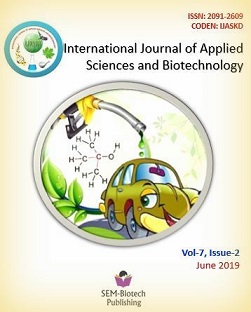Factors Affecting Ginger Production in Surkhet District, Nepal
DOI:
https://doi.org/10.3126/ijasbt.v7i2.24650Keywords:
Ginger, Production, FarmersAbstract
Ginger is a high value crop belongs to family Zingiberaceae. Ginger has multiple health benefits and can be easily grown in mid-hill regions of Nepal. The major challenge is the limited availability of information on factors affecting ginger yield. The objective of this project was to analyze different factors influencing ginger production. The study was conducted in Surkhet district of Nepal in 2018. A total of 100 farmers (60 and 40 from Barahtal and Chingad rural municipalities respectively) were selected using simple random sampling technique. Primary data were collected using interview schedule, focus group discussion and key informant interview. Data were analyzed using Statistical Package for the Social Sciences (SPSS) and Microsoft Excel. The descriptive statistics, chi-square test and correlation were used to derive conclusion. The average age and land under ginger cultivation were 41 years and 0.093 hectare respectively. Average ginger production in the study area was 980 kg per ropani. There was a strong positive relationship between farm size and ginger production. Training, subsidy and labor crisis had positive association with ginger production. However, family size and years of schooling were not significant but positively correlated. It is recommended that concerned authorities should give emphasis on farmer training, extension services, and subsidy to enhance ginger production.
Int. J. Appl. Sci. Biotechnol. Vol 7(2): 269-273




